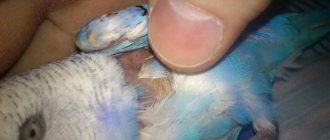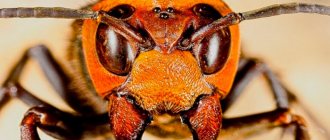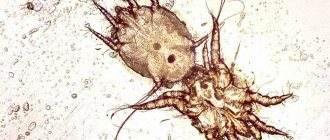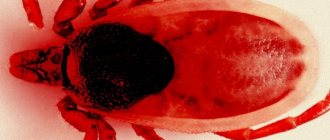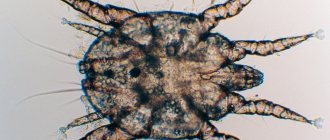Types of ticks dangerous to birds
Poultry often suffer from various mites. Small pests, invisible to the eye, live in the bodies of birds and feed on living tissues. Some types of parasites are dangerous for budgies, as they cause serious pathologies of feathers, skin and stratum corneum. In combination with other diseases, poor care, and a weakened immune system, mites multiply freely and plague the bird with constant itching.
Feather and feather mites
The common mite - syringophilosis (lat. Syringophilus bipectinatus) in parrots manifests itself as damage to the flight and tail feathers. Colonies inhabit the cavities of the ears, feeding on exudate and lymph. The shaft of an infected feather becomes black, its structure is destroyed, and the skin around it becomes inflamed. Adult females lay eggs at the base of the feather. Due to impaired blood supply, feathers break off and fall out.
Feather mites in parrots are not so easy to find, but they are also dangerous. It is a parasite with a flattened yellowish body about 2 mm long. Its food is skin cells, feather particles, and fatty grease. Down feather eaters gnaw off the beards of the feathers, leaving only the feather shafts. Over time, deformed feathers fall out, and bald patches of skin appear in their place.
Note: Feather mites can be detected by removing the perch and tapping it on a piece of white paper.
Scabies mites
One of the common diseases in parrots is knemidocoptic mange (scabies). The causative agent is a microorganism of the genus Knemidocoptes. It has a rounded body measuring 0.3 - 0.5 mm. It affects non-feathered parts of the body: the area of the beak and cere, paws, skin around the eyes, cloaca.
Scabies mites live in the skin of parrots, feed, and make their own passages. Females leave eggs there. During their life, pests release toxic waste into the tissues, which poisons the bird’s body.
Tracheal pliers
The tracheal mite lives on the mucous membrane of the trachea and lungs of an infected parrot. The disease is called sternostomosis. The causative agent is Sternostoma tracheacolum, a tiny organism measuring from 0.1 to 0.6 mm. It moves in the respiratory organs of the bird with the help of its paws and claws. Females reach the lungs, lay eggs there, and then move into the air sacs.
Life cycle 2 – 3 weeks. The mite irritates the mucous membrane, mucus secretion increases, and the parrot coughs and sneezes. Parasites and their eggs are partially excreted by coughing and settle on food, water, and cage accessories. Thus, other birds are at risk of becoming infected with tracheal mites.
Required funds
To treat the affected areas, purchase one of the following medications:
- frontline spray (spray, not drops);
- otodectin 0.1% ivermectin solution;
- chamomile (if nothing else is found).
Chamomile infusion
If you were unable to find these drugs, you can use others:
- arpalite;
- insectol;
- celandine spray.
Unfortunately, I have no experience in treatment with medications from the second list, so you will not find information about treatment with them here.
To strengthen your parrot's immunity:
- gamavit (required);
- catozal (optional);
- allowed vitamins.
Gamavit
Due to the high cost of catozal, it is not necessary to buy it. At the veterinary pharmacy, you can ask to draw a portion of catosal into an insulin syringe and buy only that, and not the whole bottle.
To treat the cage and perches, one of the preparations:
- butox;
- neostomozan;
- ecocide S.
The best option would be butox. The weakest of these three drugs is Ecocide S.
These drugs are very toxic, so it is necessary to wash the cage very carefully after treatment.
Additional accessories:
- quarantine cage (or disposable boxes with air holes);
- plastic perches;
- flower spray - atomizer;
- cotton buds;
- syringe.
The health of a parrot largely depends not only on proper care, but also on timely prevention of various diseases. Mite infestation among birds occurs quite often. You need to get rid of parasites very quickly, since their waste products lead to severe intoxication.
In the early stages of infection, ticks are difficult to detect. Severe infestation can be seen with the naked eye. The presence of parasites can be determined by the behavior and appearance of the parrot:
- the pet becomes nervous, itches constantly, its paws peel;
- growths form on the beak, wax and paws;
- the structure of the skin changes, it becomes porous, plaque forms on the beak;
- later stages of infection cause inflammatory processes throughout the body;
- As a result of intoxication, limbs may die.
If an infection is detected, the bird is isolated from other individuals. The cell is disinfected. All wooden objects (perches, ladders, toys) are replaced. The pet is being treated with medications.
We suggest you familiarize yourself with: Bars flea drops for cats and kittens
On the shelves of veterinary pharmacies there are various anti-tick remedies for parrots. Basic preparations in the form of ointments, sprays, drops. The name of the medicine is determined based on the type of parasite.
The following preparations are used to treat cages, feeders, perches, and toys:
- Ecocide C;
- Butox;
- Unostomosed.
NOTE! Mite repellents for parrots are very toxic. After processing objects and cages, everything should be thoroughly rinsed with water.
Aversectin ointment is an effective tick repellent for parrots. This veterinary drug is aimed at eliminating damage caused by scabies mites and leads to the death of the parasites themselves. The ointment fights against insects that parasitize the bird’s body. Acts selectively, destroying the pest.
The place of settlement of the causative agent of knemidocoptosis is the layers of the epidermis. The parrot is accompanied by severe irritation and itching. In severe and advanced forms, not only the beak and paws are affected, but also the feathered areas.
After applying the ointment, its effect lasts for 5 days. Complete removal from the body occurs after 10 days. Well tolerated by birds. Refers to non-hazardous drugs.
Packaging in white polymer cans, quantities from 15 g to 500 g. Apply to affected areas of the body: paws, surface of the beak, wax.
Aversectin ointment must be applied once every 5 days. If the disease is severe, 1 time every 3 days. The course of treatment is carried out until the symptoms of the disease completely disappear, followed by preventive treatment at least 2 times. As a rule, the course lasts about a month due to the incubation period of the tick is 21 days.
When treating the affected areas in the beak area, it is necessary to prevent the ointment from getting into the mouth, nasal openings and eyes of the bird.
Vaseline oil is used as an alternative. Parrot treatment is carried out in complex therapy. In addition to superficially removing parasites from the bird’s body, it is necessary to restore its immunity. Gamavit, Katazol, a complex of vitamins are used.
Some types of parasites are feather parasites and parasites. The diet of this parasite includes particles of epidermis and feather down. As a result of its negative activities, the bird loses its feathers, areas of baldness appear, up to complete nudity.
With a detailed study of the layer of feathers, the parasite can be seen with the naked eye. Symptoms of the disease include constant scratching of the bird, in some cases self-plucking of feathers, and exposed skin.
The primary species causes the disease syringophilosis. The parasite is concentrated in the edges of the tail, flight and contour feathers. The shape of the pen changes. The edge (the area of attachment to the body) takes on a brown tint.
Effective tick repellents for parrots include:
- Frontline – spray – 800 rubles per 100 ml;
- Otodectin 0.1% solution of Ivermectin – 60 rubles per 5 ml;
- Insectol - 23 UAH per 100 ml;
- Arpalit – 200 UAH;
- Celandine spray – 214 rubles per 200 ml.
Aerosol products (Insektol, Arpalit, Celandine - spray) are sprayed onto the body of the bird from a distance of 25 cm. This prevents the medicine from getting into the eyes, mouth and nose.
Frontline - spray, in addition to surface irrigation, is also applied to a cotton swab or brush, which is used to treat the skin in the back of the head area, under the wings. By treating the skin, the medication does not get on the feathers. The drug lasts in the parrot's body for 2 - 3 weeks. The procedure is repeated at least 4 times, applied once every 5 days.
Otodectin 0.1% Ivermectin solution is applied to the skin of the back of the head with one drop. 3 – 4 procedures are carried out once every 8 days.
The parasite irritates the mucous membrane of the trachea and affects the respiratory system. The parrot's voice changes or completely disappears. Coughing, wheezing, throwing back of the head, and regurgitation of food in large quantities appear.
Strenostomosis is treated with Ivermectin. The medicine has a paralytic effect on the neuromuscular endings of the tick. Mature individuals are destroyed. The product does not affect parasite eggs.
Dosage of Ivermectin 0.2 mg/kg up to 3 times with an interval of 10 to 14 days. The effect of the drug lasts 8 – 11 days.
To destroy parasite eggs, Permethrin is used in combination with Imidacloprid. Proportions: 10% Imidacloprid plus 50% Permethrin. Permethrin can be replaced with Dectomax.
Prices for basic drugs:
- Ivermectin 1% 260 rubles per 100 ml.
- Permethrin 20% concentrate from 900 rubles per 500 ml.
- Dectomax 50 ml from 850 rubles.
We suggest you read: How to fight aphids on trees
To ensure a healthy lifestyle for your feathered pet, preventive treatment of the cage should be carried out every month with special products or a manganese solution. Change wooden accessories. Food and water should always be fresh. With proper care, the parrot will delight its owner for many years.
Reasons for appearance
A tracheal mite may appear in a parrot after it is fed by a sick partner. Also, parents feeding chicks can infect them. By feeding from a feeder with eggs on it, fiddling with twigs, or simply breathing in the air next to a sneezing neighbor, the bird runs the risk of getting sick.
Transmission of feather and chin mites in budgerigars occurs by contact: in the presence of a sick bird. Parrots with strong immunity can be carriers, and characteristic signs will become noticeable only in the active phase of the disease. In addition, there are other sources of the disease:
- used cage, equipment without disinfection;
- unprocessed twigs;
- insufficient hygiene;
- poor quality food.
The same can be said about the scabies mite - the ways of obtaining these pests are largely similar. For the most part, already infected parrots are brought home from the pet store. Sometimes several types of parasites appear on one bird.
Attention! Mistakes made in care have a detrimental effect on birds. Cold and dampness, poor nutrition, overcrowding, and unsanitary conditions are the main conditions for mite infection.
Symptoms and danger of infection
At first, it can be difficult to understand that a parrot has contracted an unpleasant disease. Pests can live in the body for over three months without showing their presence in any way. Changes in appearance do not appear immediately, and there is nothing special in behavior: healthy birds also often scratch and preen themselves.
Signs by which knemidocoptosis in parrots is determined:
- If the paws are affected, the skin scales rise and the metatarsus becomes lumpy. The bird gnaws its fingers, moves on its perch, and cannot find a place for itself. Gray growths appear and joints become inflamed. Without appropriate treatment, loss of claws and even the limbs themselves is possible.
- If the scabies mite parasitizes the beak and wax, their color and shape change. There are wounds and cracks in the corners of the beak. The beak bends, twists, and grows faster than usual.
- The cloaca seems to be covered with a coating of lime. This causes particular inconvenience for the female; she cannot lay eggs.
- The skin around the eyes becomes covered with yellowish scabs, and small feathers fall out.
- Ticks can settle on the feathered area of the body. Large pores appear on the skin, crusts accumulate, and the affected areas become inflamed.
The mite causes severe itching. The plumage loses its uniform volume and shine, the feathers on the tail and wings become fragile, break off, and fall out. The parrot plucks its feathers and itches furiously, tearing its skin until it bleeds. This behavior is accompanied by loss of appetite and weight loss. In young individuals, growth slows down, and the immune system cannot cope with other diseases.
Note: The diagnosis is made by comparing the fallen feathers with the feathers of a healthy bird. The shaft of a diseased feather is dark, filled with a thick mass.
The fact that the bird has been infected by a tracheal mite can be assumed from the following symptoms:
- voice goes down or disappears;
- the parrot throws back its head;
- the beak is open for a long time;
- difficulty breathing with whistling;
- cough, sneezing;
- discharge of mucus from the beak and nostrils.
Epithelium accumulates in the bird's respiratory tract, mucus fills small passages, obstruction, suffocation and death occur.
General symptoms are lethargy, lack of appetite, and lack of interest in toys. Skin peeling, itching, feather loss. All these types of tick-borne diseases are contagious. If illness is suspected, the parrot should be left alone in the cage and quarantined. Don’t rush to place your new pet with other birds, watch it for a while.
Why does a tick appear?
Parrots get ticks from insufficient hygiene. The bird cage and accessories must be periodically washed and doused with boiling water. Such measures will prevent the emergence and reproduction of the parasite. In most cases, a parrot becomes infected with a tick already in a pet store. When purchasing a bird, you need to carefully examine it, especially the areas not covered by feathers.
If there are already other parrots in the house, you should not rush to add a new pet to them. It is important to observe the behavior of the bird, its appetite, and appearance.
Typically, small breeds of parrots are susceptible to the disease; large birds are rarely affected by the tick.
Stages of the disease
A tick in a parrot is not immediately detected. Knemidocoptosis has four stages:
- Initial. There are no symptoms, but pathogens are already in the body;
- Easy. When examining the bird, bumps are found on the skin, the structure changes, and the pores expand. Peeling, plaque on the beak and wax, thinning of feathers;
- Average. The itching is very uncomfortable. The bird bites its legs, scratches its beak, gnaws and plucks feathers. Due to beak deformation, it does not take food. The parrot's legs are covered with growths, scabs hang around the eyes;
- Heavy. The feathers have already partially fallen out. The beak is bent, cracked, and there are bleeding wounds in the corners. A thick layer of epithelium has grown on the cere, covering the nostrils. This is an extremely dangerous condition when the bird can die any day now.
Oral medications
From the beginning of the course of treatment, the parrot is given Gamavit (and, if available, Catozal). These drugs support the immune system and rid the body of toxins (if the ointment gets inside).
gamavit: 0.5 ml per 50 ml of water, in a drinking bowl, course 7 days; catozal: 0.2 ml per 50 ml water, together with Gamavit, course 5 days. Due to the fact that gamavit spoils very quickly, it is necessary change every 4 hours. At night, the bird is given clean water. If this is not possible, then gamavit is dripped into the corner of the beak, 1 drop once a day, 7 days. The bottle of Gamavit should not be opened. Draw into a syringe and store it in the refrigerator. Spoiled gamavit will change color.
5 days after the end of the course of Gamavit (i.e., from the 13th day of treatment), a course of drinking vitamins is started (if a month has passed since the last course).
Features of treatment
To completely get rid of ticks in parrots, treatment should not be delayed. It is necessary to start no later than the mild stage of the disease. At this stage, a successful outcome is almost guaranteed. An advanced disease is difficult to correct; you have to spend a lot of time, effort and money.
Treatment rules
First of all, if you notice unusual behavior in your pet, take it to an ornithologist for an examination. It is not always possible to determine the cause of the disease at home. Blood and feather tests may need to be done. The doctor will prescribe medications and write out a treatment regimen. If the parrot is examined at the onset of the disease, the course of treatment will be short - no more than three weeks.
A sick bird requires complete isolation. Do not let her out of the cage until the end of treatment. To prevent infection, it is necessary to observe quarantine, thoroughly wash and disinfect the cage and all accessories. Birds should not be allowed to breed if any of them have mites. How to cure a bird? Purchase veterinary drugs and use them according to instructions.
Scabies is the easiest way to cure: you just need to be patient and do not miss a single treatment session. The tracheal mite is difficult to remove, but suitable drugs have been invented to expel it.
Necessary drugs
The veterinarian's pharmacy has effective remedies for bird mites:
- aversectin ointment;
- ivermectin or dectomax;
- Vaseline oil.
Mite ointment for parrots kills both the parasites themselves and the egg clutches. You can use analogues: avermectin or norvertine ointment. Vaseline oil only affects pathogens; the course of treatment in this case lasts 3 weeks or more.
A decoction of chamomile flowers will help relieve inflammation from the skin. Mites in a parrot appear against the background of reduced immunity, so gamavit, catozal, and vitamin supplements are prescribed for support.
Parrot treatment
When treating a sick bird, aversectin ointment is applied with cotton wool or a soft brush to the defective areas. You should not touch the eyes, nostrils and tongue of the bird, because this is a toxic drug. Use once a day every five days until the growths are completely removed, after which two control procedures are carried out.
Vaseline oil is harmless; it can be used to lubricate any affected area, even the eyelids. The operating principle of the oil is based on restricting air access. In clogged passages, parasites suffocate and die. It takes longer to treat a parrot with oil than with ointment, and treat the skin at least twice a day.
In the case of a tracheal mite in a budgerigar, you need to proceed as follows: dilute ivermectin 1% at the rate of 1 ml per 1 liter of water, add to the drinking bowl or inject into the beak using a syringe without a needle. Give for four days in a row, then take a break for two weeks and repeat the four-day course. In case of an overdose, the parrot may die.
Ivermectin has many analogues: permethrin, ivomec, otodectin, dectomax. The method of application is the same: spreading the feathers on the withers or inside the wing, drop 1 - 2 drops of the drug onto the skin. The duration of treatment is from seven to fourteen days, since these drugs are stored in the body for 11 to 18 days.
Disinfection of equipment and cages
For the entire duration of treatment, the parrot must be placed in another cage. Old - disinfect with one of the following liquids:
- neostomozan;
- butox;
- ecocide-S.
Dilute half an ampoule of Butox or Neostomosan in one liter of warm water. If Ecocide-S is selected, then the ratio should be 10 g of powder per 1 liter of water. Disinfecting the cage and accessories is not at all difficult. Place the cage in the bath bowl, spray it with a spray bottle, and leave for two hours. After this, rinse with plenty of water, rinse with boiling water, and dry. Plastic feeders and drinkers should be scalded, but not treated with chemicals. Wooden equipment should be thrown away and new items should be purchased.
Sources of tick infection
By following these simple tips, you can minimize the likelihood of your parrot becoming infected with a tick mite:
- varied, proper, nutritious nutrition;
- branded, high-quality food;
- maintaining hygiene, daily routine and weekly complete cleaning of the cage;
- treating new accessories or cages in the correct way;
- daily flights;
- daily live communication;
- lack of stress;
- no contact with any birds that have not undergone quarantine.
Even if the parrot has recovered, it is possible that it may become re-infected if the parasite in the bird’s cage has not been completely eradicated. It may remain on some parts. It is possible that the tick was preserved outside the cage, in the places where the parrot usually sits. Therefore, not only the cage and the objects in it must be treated, but also all places in the apartment where the parrot most often visits.
The cell is disinfected twice - before and after treatment. The best option would be to purchase a new cage with all the accessories. In this case, the risk of re-infection is sharply reduced.
Prevention methods
To prevent the appearance of ticks and fluff eaters, the following measures can be taken:
- observe quarantine;
- wash and disinfect equipment in a timely manner;
- feed the birds well;
- buy high-quality grain mixtures;
- pour boiling water over branches, greens and fruits;
- Take your pets to the doctor regularly.
Budgerigars can have different types of mites: tracheal mites, feather mites, scabies and others. Pests cause serious damage to the health of feathered pets, but are not dangerous to humans. It is important to learn to recognize diseases in order to protect birds from serious consequences.
